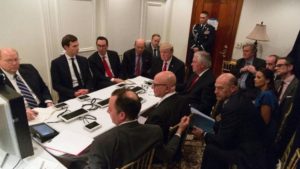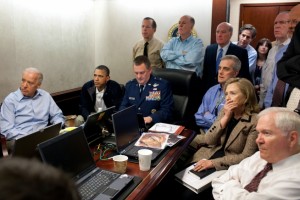As President Trump was launching
his missile strike against Syria, CIA Director Pompeo, pictured above, and other intelligence
officials weren’t at the table, suggesting their doubts about Bashar al-Assad’s
guilt, reports Robert Parry.
By Robert Parry
There is a dark mystery behind
the White House-released photo showing President Trump and more than a dozen
advisers meeting at his estate in Mar-a-Lago after his decision to strike Syria
with Tomahawk missiles: Where is CIA Director Mike Pompeo and other top
intelligence officials?

The photograph
released by the White House of President Trump meeting with his advisers at his
estate in Mar-a-Lago on April 6, 2017, regarding his decision to launch missile
strikes against Syria.
Before the photo was released on
Friday, a source told me that Pompeo had personally briefed Trump on April 6
about the CIA’s belief that Syrian President Bashar al-Assad was likely not
responsible for the lethal poison-gas incident in northern Syria two days
earlier — and thus Pompeo was excluded from the larger meeting as Trump reached
a contrary decision.
At the time, I found the
information dubious since Trump, Secretary of State Rex Tillerson and other
senior U.S. officials were declaring quite confidently that Assad was at fault.
Given that apparent confidence, I assumed that Pompeo and the CIA must have
signed off on the conclusion of Assad’s guilt even though I knew that some U.S.
intelligence analysts had contrary opinions, that they viewed the incident as
either an accidental release of chemicals or an intentional ploy by Al Qaeda
rebels to sucker the U.S. into attacking Syria.
As strange as the Trump
administration has been in its early months, it was hard for me to believe that
Trump would have listened to the CIA’s views and then shooed the director away
from the larger meeting before launching a military strike against a country
not threatening America.
After the strike against Syria by
59 Tomahawk missiles, which Syrian
officials said killed seven people including four children, Trump
gave a speech to
the American people declaring flatly:
“On Tuesday, Syrian dictator
Bashar al-Assad launched a horrible chemical weapons attack on innocent
civilians. Using a deadly nerve agent, Assad choked out the lives of helpless
men, women, and children. It was a slow and brutal death for so many. Even
beautiful babies were cruelly murdered in this very barbaric attack. No child
of God should ever suffer such horror.”
As much as Trump stood to benefit
politically by acting aggressively in attacking Syria — and thus winning praise
even from his harshest critics — the idea that he would ignore the views of the
U.S. intelligence community on an issue of war or peace was something that I
found hard to believe.
So, I put aside what I had heard
from the source about the discordant Pompeo-Trump meeting as the sort of tidbit
that may come from someone who lacks first-hand knowledge and doesn’t get all
the details right.
After all, in almost every
similar situation that I had covered over decades, the CIA Director or the
Director of National Intelligence has played a prominent role in decisions that
depend heavily on the intelligence community’s assessments and actions.

President Barack Obama
and his national security team monitor the Special Operations raid into
Pakistan that killed Osama bin Laden. (White House photo by Pete Souza)
For instance, in the famous photo
of President Obama and his team waiting out the results of the 2011 raid to
kill Al Qaeda leader Osama bin Laden, CIA Director Leon Panetta is the one on
the conference screen that everyone is looking at.
Even when the U.S. government is
presenting false information, such as Secretary of State Colin Powell’s 2003
speech laying out the bogus evidence of Iraq hiding WMDs, CIA Director George
Tenet was seated behind Powell to lend credibility to the falsehoods.
At the Table
But in the photo of Trump and his
advisers, no one from the intelligence community is in the frame. You see
Trump, Secretary of State Tillerson, National Security Adviser H.R. McMaster,
White House chief of staff Reince Priebus, strategic adviser Steve Bannon,
son-in-law Jared Kushner and a variety of other officials, including some
economic advisers who were at Mar-a-Lago in Florida for the meeting with
Chinese President Xi Jinping.
However, you don’t see Pompeo or
Director of National Intelligence Dan Coats or any other intelligence official.
Even The New York Times noted the oddity in its Saturday editions, writing: “If
there were C.I.A. and other intelligence briefers around, … they are not in the
picture.”
That made me wonder whether
perhaps my original source did know something. The claim was that CIA Director
Pompeo had briefed Trump personally on the analysts’ assessment that Assad’s
forces were not responsible, but – then with Pompeo sidelined – Trump conveyed
his own version of the intelligence to his senior staff.
In other words, the other
officials didn’t get the direct word from Pompeo but rather received a
second-hand account from the President, the source said. Did Trump choose to
rely on the smug certainty from the TV shows and the mainstream news media that
Assad was guilty, rather than the contrary view of U.S. intelligence analysts?
After the attack, Secretary of
State Tillerson, who is not an institutional intelligence official and has
little experience with the subtleties of intelligence, was the one to claim
that the U.S. intelligence community assessed with a “high degree of
confidence” that the Syrian government had dropped a poison gas bomb on
civilians in Idlib province.
While Tillerson’s comment meshed
with Official Washington’s hastily formed groupthink of Assad’s guilt, it is
hard to believe that CIA analysts would have settled on such a firm conclusion
so quickly, especially given the remote location of the incident and the fact
that the initial information was coming from pro-rebel (or Al Qaeda) sources.
Thus, a serious question arises
whether President Trump did receive that “high degree of confidence” assessment
from the intelligence community or whether he shunted Pompeo aside to eliminate
an obstacle to his desire to launch the April 6 rocket attack.
If so, such a dangerous deception
more than anything else we’ve seen in the first two-plus months of the Trump
administration would be grounds for impeachment – ignoring the opinion of the
U.S. intelligence community so the President could carry out a politically
popular (albeit illegal) missile strike that killed Syrians.

No comments:
Post a Comment